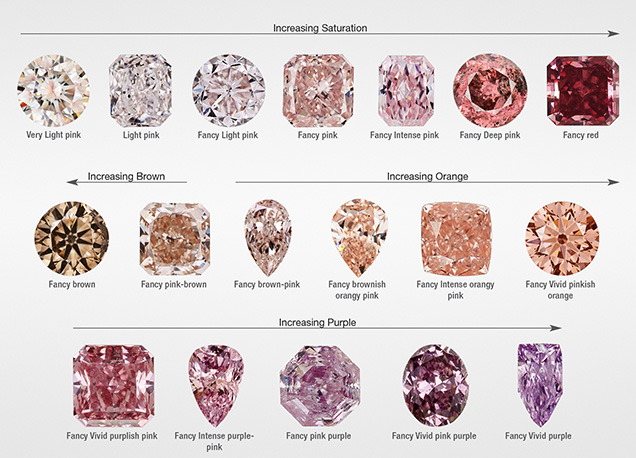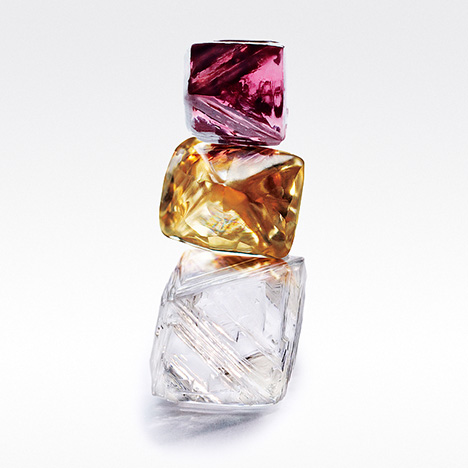Diamond is one of the most extraordinary materials on Earth. Fancy-color natural diamonds are among the most valued gems because of their great rarity.
The article proposes to provide an overview of the gemological characteristics of natural “pink” diamonds, mainly colored by an as-yet-unidentified “550 nm” absorption band, to put at your fingertips how these diamonds with extremely valuable colors originate.
We will talk about all-natural fancy-colored diamonds with as predominant tonalities of red, pink or purple. And also unmodified brown. Diamonds with yellow-brown or orange-brown will be treated separately.
INTRODUCTION
During eight years (2008-2016), GIA has seen more than 90.000 rose diamonds. The majority of which were unmodified pink (40%). And in a lower percentage, there was pinkish purple to purplish pink (28%), brownish pink to pinkish brown (17%), and orangy pink (10%).
The rarest colors were unmodified brown (3%); purple with brown or gray modifiers (1%); unmodified red (0.5%); red with brown, purple, or orange modifiers (0.4%); and, least of all, unmodified purple (0.05%).

CAUSES OF COLOR
It is more difficult for the human eye to interpret subtle hue differences for very light-colored diamonds than for more saturated diamonds. (54% were Faint, Very Light, or Light in color)
With this in mind, the lightest color grades, are used fewer hue names, and the color description covers a wide range of the hue wheel.
Colored Deformation Lamellae. The color is concentrated within parallel narrow bands (commonly defined as colored lamellae) in many brown, pink, and purple diamonds. When manufactured as cut stones, these are oriented to minimize the lamellae’s face-up facade, giving an apparent color even distribution.
Normally, on most of the diamonds, the existence of these lamellae are closely associated with brown, pink, or purple colors.
Brown General Absorption. The brown color is quite common in natural diamonds. While brown diamonds are abundant, most are either not faceted or not submitted for grading reports unless there is another contributing color (pink, orange or yellow). As mentioned previously, only 3% of the 90,000+ samples studied here had an unmodified brown color.
Owing to its abundance is traditionally valued less than other diamonds.
550 nm Visible Absorption Band. The most common cause of the “pink” color is a broad absorption band around 550 nm. This effect has not yet been identified but has been associated with plastic deformation.
Nitrogen-Vacancy Centers. “Pink” diamonds naturally colored by NV0/– centers are extremely rare; nevertheless, these centers are the main cause of color in treated and synthetic “pink” diamonds.
They are often referred to as “Golconda pink” diamonds. A famous example is the 34.65 ct Fancy Intense pink Princie that has been sold at auction for more than $39.3m (£25m). While the Princie originates from the historic mining region of Golconda in India, today, the term “Golconda” is generally associated with this cause of color and not with any geographical link to the ancient mining region.
OCCURRENCE AND FORMATION
The formation mechanism for “pink” diamonds in the earth varies significantly depending on the defects responsible for the color. The Argyle mine is well known as a source for pink diamonds, in spite of representing merely 0.1% of the overall production, where 72% of the production is brown and 27% is colorless to yellow. But, before the opening of Argyle mine in Australia (1983) there wasn’t a stable supply of “pink” diamonds. More recently, mines in regions of Russia have been producing pink to purple-pink diamonds.
Finding new deposits with “pink” diamond production is important to the commerce because on 2020 the activity on Argyle mine will stop.

“Pink” Diamonds with 550 nm Absorption Band.
Occurrence. Nitrogen content and the extent of nitrogen aggregation in the atomic structure, and by inference the diamond’s geographic origin, lead to very different observations of how the “pink” color due to the 550 nm band is distributed within the diamond.
There are a lot of locality data available on type Ia “pinks”. But not for type IIa “pink” diamonds. Even so, there is ample and consistent evidence to think that type IIa “pinks” match with Argyle “pinks,” such as color range or the presence of wavy graining in some type IIa diamonds. However, reports about the output of the Argyle mine exclude type IIa diamonds.
Formation. Pink-brown color is often associated with deformation lamellae in the diamond, and the mountain building is responsible for this deformation.
The remnants of mountain ranges that developed during collisional processes billions of years ago, and have since been eroded away, are called “orogens.” During the continental collision, rocks become deformed with mineral recrystallization, taking on a “flow” texture.
The Argyle mine is located in one of these areas that experienced a continental collision; the Proterozoic Halls Creek orogen. Argyle diamonds were formed because of those collisional processes, and after their formation, they resided near the base of the lithosphere. In this high-temperature, high-deformation environment, the pink-brown-red color in these diamonds probably originated.
Despite this, diamonds’ presence within an orogenic belt does not necessarily result in pink-brown colors. Ellendale mine is a clear example of that.
Pink Diamonds with NV0/– Centers.
Occurrence. Although pink diamonds colored by NV 0 / – centers (i.e., “Golconda roses”) are associated with ancient diamond mining of Golconda, there are no known reliable modern sources in the region. It was said that natural diamonds with sufficient NV 0 / – absorption to contribute to the pink color are rare.
Formation. NV0/– centers are formed when vacancies in the diamond lattice are trapped next to nitrogen. These defects are rarely observed in nature but are ‘’easy’’ to create in a laboratory.
CONCLUSIONS
Most colored diamonds are formed when they are in the Eart’s mantle. One reaches the earth’s surface; diamonds can be exposed to radiation to create blue to green colors. However, the vast majority of natural “pink” diamonds colored by the 550 nm absorption band are produced through deformation processes deep within the earth.
Source: https://www.gia.edu/gems-gemology/winter-2018-natural-color-pink-purple-red-brown-diamonds








